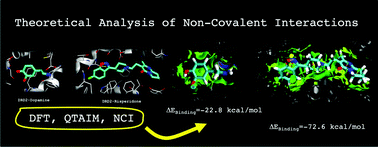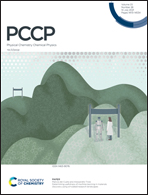Main interactions of dopamine and risperidone with the dopamine D2 receptor†
Abstract
Psychosis is one of the psychiatric disorders that is controlled by dopaminergic drugs such as antipsychotics that have affinity for the dopamine D2 receptor (DRD2). In this investigation we perform quantum chemical calculations of two molecules [dopamine and risperidone] within a large cavity of DRD2 that represents the binding site of the receptor. Dopamine is an endogenous neurotransmitter and risperidone is a second-generation antipsychotic. Non-covalent interactions of dopamine and risperidone with DRD2 are analyzed using the Quantum Theory of Atoms in Molecules (QTAIM) and the Non-Covalent Interaction index (NCI). The QTAIM results show that these molecules strongly interact with the receptor. There are 22 non-covalent interactions for dopamine and 54 for risperidone. The electron density evaluated at each critical binding point is small in both systems but it is higher for dopamine than for risperidone, indicating that the interactions of DRD2 with the first are stronger than with the second molecule. However, the binding energy is higher for risperidone (−72.6 kcal mol−1) than for dopamine (−22.8 kcal mol−1). Thus, the strength of the binding energy is due to the number of contacts rather than the strength of the interactions themselves. This could be related to the ability of risperidone to block DRD2 and may explain the efficacy of this drug for controlling the symptoms of schizophrenia, but likewise its secondary effects.

- This article is part of the themed collection: 2021 PCCP HOT Articles


 Please wait while we load your content...
Please wait while we load your content...